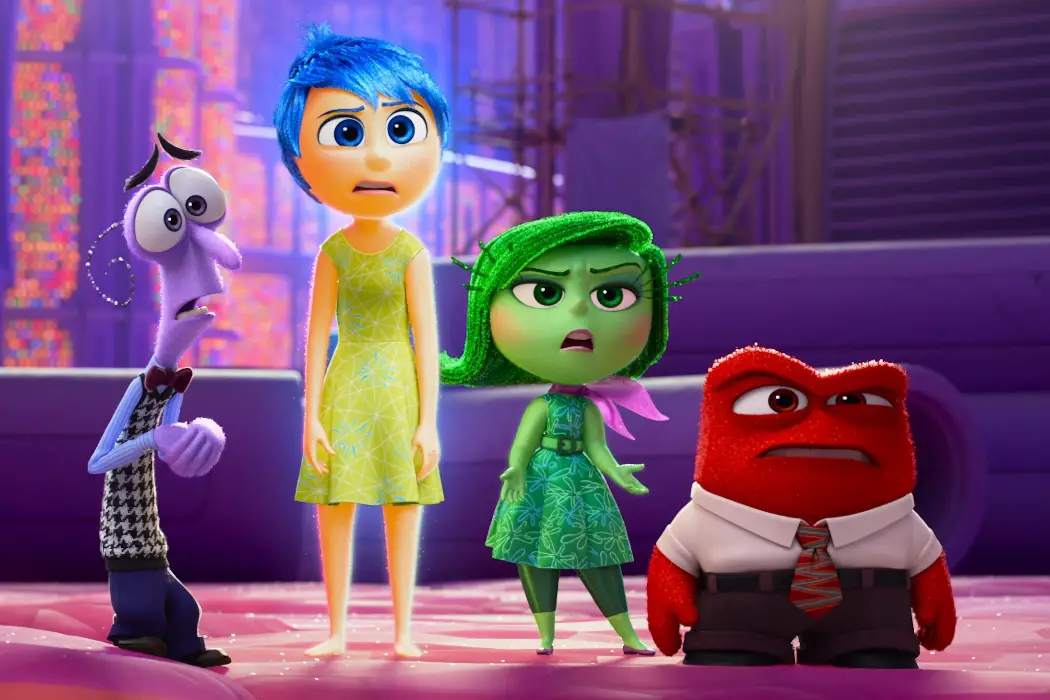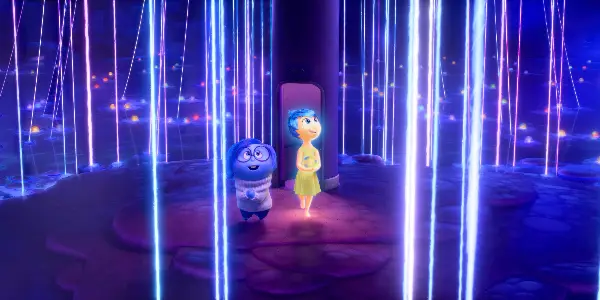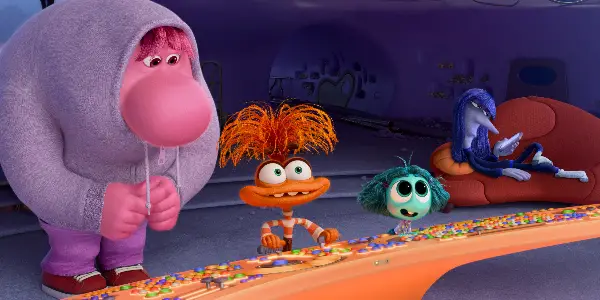INSIDE OUT 2: Pixar Is Eating Its Own Tail

Film critic, Ithaca College and University of St Andrews graduate,…
Inside Out 2 introduces a bunch of new emotions, but the only one I felt watching it was Apathy. Pixar’s most hamfisted story — what if emotions had emotions? — returns a whole nine years after the original, and the cobwebs are not only visible, but this time around it’s all cobwebs. With a creaky story, a total absence of logic, and the most squeaky-clean depiction of puberty you could imagine, Inside Out 2 feels less like a $200 million film and more like a cash-grab made-for-TV movie.
Pixar’s downward trend since the late aughts has been one for the history books. It’s not as though the company had a Midas touch for its first few years — A Bug’s Life and Toy Story might be childhood favorites, but their outdated animation feels blocky and labored compared to the company’s pristine later works. Nevertheless, Pixar quickly gained a reputation as the Studio Ghibli of the West, whether or not that was earned. After its acquisition by Disney in 2006, it’s been pumping out half-baked ideas and lazy sequels, seemingly governed more by profit incentives than by an earnest desire to tell great stories. Never has this been more clear than in May 2024, when Disney CEO Bob Iger said Pixar and Walt Disney Animation Studios would be “swinging back a bit to lean on sequels” after the disappointing financial returns of Lightyear, Turning Red, Luca, and Elemental. Into this breach plopped Inside Out 2, which accidentally became the poster child of Pixar’s new IP-first approach to filmmaking. Not only is the film itself an unimaginative slog bereft of jokes, sanded down so much as not to offend or entertain anybody, but it’s also the herald of a frustrating new era of corporate desperation for a company that once prided itself on innovative storytelling.
Everybody Hates Anxiety
Inside Out and its sequel take place mostly inside the mind of a young girl, Riley (Kensington Tallman). In the first film, her emotions, personified within her mind’s command center, are Joy (Amy Poehler), Sadness (Phyllis Smith), Anger (Lewis Black), Fear (now voiced by Tony Hale), and Disgust (now voiced by Liza Lapira). Those new voices are replacing the actors who had too much self-respect to accept a $100,000 paycheck while Poehler got $5 million to return. Last time, Riley dealt with a chaotic move to San Francisco, where the main antagonist in her life was… broccoli pizza, if I remember correctly. Everybody who’s terminally on Twitter and Tumblr walked away from the film with a thirst for Pixar’s hottest new dad (Kyle Maclachlan), while the rest of us got a sweet lesson about how sadness is an important emotion and the role it serves in the greater emotional potpourri of our lives. Also we learned what a Bing-Bong was, and I swear to God, if I ever see him in real life I will kill him with a hammer.
Inside Out ended with a threatening tease of puberty coming for poor Riley, and Inside Out 2 makes good on that promise. We get a hasty set-up for this sequel’s new bells and whistles — Riley’s headed off to hockey camp, while inside her mind, Joy developed a new Sense of Self tool that houses all of Riley’s happiest, most essential memories. This new thingamajig apparently also has the power to determine her beliefs. Joy thinks she has Riley all set for success, but then, on the first day of hockey camp, puberty strikes. (Pause for dramatic thunder and lightning.)

Little mind marshmallows with mustaches and construction equipment gut the control room, replacing the gang’s control panel with a new, much more elaborate one. And some new coworkers arrive, too: Anxiety (Maya Hawke), Envy (Ayo Edebiri), Ennui (Adèle Exarchopoulos), and Embarrassment (Paul Walter Hauser). Anxiety clashes with Joy over their opposing plans for Riley’s hockey camp experience — and, in turn, the rest of her life — culminating in Anxiety taking over and expelling the old emotions and Riley’s Sense of Self to the far recesses of her mind. The remainder of the film tracks the gang’s quest to reclaim Riley’s Sense of Self and get back to the control panel, while at HQ Anxiety and pals only make Riley’s life worse.
Does This Actually Make Sense To Anyone?
Despite a plot that felt like a 5-year-old drew it in crayon on a piece of construction paper, Inside Out managed to articulate a competent metaphor for adolescence. I can imagine the personified emotions and fleshed-out world of Riley’s mind helped people of all ages grapple with their own emotions and learn how their brains work.
Pixar has always been using storytelling as a way to help us understand the world. Finding Nemo makes coral reef ecosystems fun and comprehensible. Monsters, Inc. provides a fully developed world to explain the monsters you might’ve thought were in your closets and under your beds. WALL•E creates a believable look at the potentially catastrophic effects of climate change and corporate greed. In line with those films, Inside Out is on some level a tool to teach people about psychology. The filmmakers consulted psychology professors and neuroscientists as they wrote the script. The movie’s main advisor went on NPR’s Science Friday to tell Ira Glass about its groundbreaking depiction of emotions. The film was praised by psychologists, psychiatrists, and therapists — Inside Out was the first children’s film to depict emotions in a sophisticated way, using animated characters to illustrate complex ideas like evolutionary fight-or-flight, the theoretical relationships between emotions, and the role of emotions in cognition. I’d be surprised if it isn’t screened in psych classes every year across the country.
So what the heck happened with Inside Out 2?
When developing the original film, the writers and their psychological consultants bandied about the idea of including all 27 emotions currently understood by scientists. That was dropped to streamline the plot and characters — and it also helped evade some confusion, because what’s the difference between horror and fear, or triumph and joy? The decision to condense these 27 emotions into a central quintet is actually pretty brilliant — the implication that Inside Out makes is that these five core emotions are like primary colors. They are the stuff from which all other emotions derive. That also helps explain the inconsistencies in the fabric of the story — it doesn’t really make much sense that Joy is capable of experiencing sadness, for instance, or that Sadness can feel happiness, but that plot hole can be quickly papered over if you instead consider that these emotions contain and represent multitudinous other emotions.
In the sequel, though, every emotion just casually displays all manner of other emotions willy-nilly. In one part of the film, Joy gets depressed, somehow, and loses her hope. In one scene, Anger becomes sympathetic and shows kindness and understanding. Disgust becomes sort of like an amalgamation of contempt, cattiness, distrust, and envy (despite that Envy is literally a separate character now).
Inside Out 2 not only throws the idea of five core emotions out the window, but it also introduces so many more inconsistencies into its world. For instance, in all of our glimpses of other characters’ minds in the first film, we never saw emotions besides the core five — so did all the old emotions in Mom and Dad just team up to kill Anxiety? In a scene late in Inside Out 2, set inside the mind of one of Riley’s parents, a version of Anxiety appears from behind a curtain to make a cameo. The old I-was-there-the-whole-time trick. The film implies, though, that anxiety — along with all of those other pesky puberty emotions like Envy, Embarrassment, and Ennui — is only relevant for your teenage years and that adults don’t deal with it. Which is patently wrong. SO MANY TWEENS could take this as Hard Science and then go into their 20s riddled with anxiety, thinking that something is horribly wrong with them and that they need lobotomies because the Pixar movie they watched when they were 12 years old told them that Anxiety was a temporary thing. In the real, non-cartoon world, these emotions don’t just go away or sit backstage once you finish puberty. Ask literally any adult if you don’t believe me. It’s not only disingenuous but irresponsible to suggest otherwise.
Original-recipe Inside Out is so giddy about its own premise that it takes almost every opportunity to show us inside the minds of other characters. Mom, Dad, cats, dogs, you name it. That’s a beat that Inside Out 2 misses — which is a shame, because it’s already on shaky ground with its depiction of Anxiety. Anxiety is a complex response, ranging from the natural anxiety we all feel when we walk through a dark car park at night to anxiety disorders, characterized by excessive, frequent bouts of fear or worry that are difficult to control and negatively affect a person’s ability to live life normally. Not everybody experiences anxiety or anxiety disorders in the same way, just as not everybody has the same solutions to dealing with anxiety, and this would have been valuable to see in the film. If we’re getting a lesson on how Anxiety messes us up during puberty and our teenage years, seeing boring old white-bread Riley deal with the Maya Hawke in her brain is only useful to the extent that we can recognize ourselves in that relationship.
While we’re at it, a note on the character designs: Why are they like that? Anxiety is the most interesting new design but also the one that most resembles a Crazy Bones toy. The rest continue the worst design trend from Inside Out — despite being emotions, they’re all heavily gendered. It’s pretty sexist that Disgust is the most femme emotion, while Embarrassment is a fat dude showing plumber crack and Nostalgia (June Squibb) is a sweet old grandmother. These animators have so much to work with and so many directions they can take these abstract concepts in — in Soul, some characters were just 2D neon lines that formlessly glide through space — so why are the character designs in Inside Out and its sequel so unimaginative?
Sar-Chasms And The Personality Sub-Basement
Much of the fun in Inside Out comes from how the film’s writers, production designers, and animators interpreted what we know about the workings of the human mind. Core memories, the five islands of Riley’s personality, the depiction of long-term memory, Imagination Land, and the dream production studio are all literal objects or places inside Riley’s mind that have clear analogs in modern psychology and neuroscience. Inside Out isn’t perfect at balancing its metaphors, but one can reasonably explain even the clumsier events within the film, like the crumbling of Riley’s personality islands, as still being within the window of believability for that specific metaphor to function.
Inside Out 2, meanwhile, abandons all attempts at metaphor and kind of just makes shit up. When Ennui gains control of Riley for a moment, she says something extremely sarcastic, causing a “sar-chasm” to open in her mind. It’s a cute visual gag, but why does a sarcastic remark rip a gaping hope through Riley’s mind? If she makes sarcasm a core aspect of her personality, will her mind eventually split itself into a hundred pieces? Is that what happened to Aubrey Plaza?

So many other elements in the film don’t make sense because they have no clear real-world psychological counterparts — the stream of consciousness, the pipe that Joy builds to shoot negative memories to the back of the mind, Ennui’s iPad, the pillow fort, and those aforementioned little marshmallow dudes are examples of Inside Out 2’s plot-first, science-last attitude.
One of the most egregious examples of this also happens to be the main thrust of the story. At the start of the film, we see that Joy has created a pool of eternal memories in the sub-basement of Riley’s mind. This opens a whole other can of worms — does this not exist in everyone else’s brain? If Joy had to dig it herself, is Riley a more psychologically complex character than the other kids in the film? And how much autonomy does this mean that each individual Joy has?
In the pool, all of Riley’s core memories combine to form Riley’s Sense of Self. Except neither the memory pool nor the Sense of Self mechanism have analogs within the actual human brain. One’s sense of self is determined by far more than just emotions and experiences. Religion, politics, economic circumstances, race, gender, sexuality, and a whole Inside Out 3 worth of other stuff also help to determine one’s sense of self. Yet they don’t fit into Pixar’s tidy little depiction of the human mind, so they aren’t included.
How Inside Out 2 Depicts Puberty
Inside Out 2 has a puberty problem. I don’t know what committee wrote this film, but I’ve never seen a movie supposedly about puberty that has so little to do with actual puberty. This is not a film for tweens but one instead for 20-somethings who care way too much about realistic depictions of anxiety attacks in their children’s cartoons. Inside Out 2 reduces puberty to a mere emotional imbalance, completely ignoring so much of what actually happens to someone during puberty.
There’s no mention of sexuality, no depiction of the impact of hormones on emotions, and barely any physical effects besides a joke about how Riley’s armpits suddenly stink. What about Valentina (Lilimar), the ice hockey bad girl with a streak of red in her hair? Riley so clearly wants to make out with her, but I guess we’ll just have to let that remain as subtext.
So many animated movies aimed at tweens do a better job of explaining the physical, emotional, and psychological effects of puberty — films like Studio Ghibli’s Only Yesterday and Pixar’s own Turning Red. And those movies have so much else going on besides the puberty stuff! Only Yesterday is, like, 3% about puberty (and 20% about harvesting safflower) and still nails it in a way Inside Out 2 simply doesn’t. Turning Red is an animal transformation story that ends with a kaiju battle in Toronto, and it still makes for a better allegory about puberty. Inside Out 2 by comparison is a boring story full of missed opportunities.
Conclusion: Inside Out 2
You don’t need to be a scientist to see that Inside Out 2 is just a bad, lazy movie. There are maybe three jokes in the entire film; the animation is always competent but never dazzling; and the story beats feel recycled from a dozen Disney Channel Original Movies that didn’t cost $200 million each to produce. It copies the same formula from Inside Out without any of the whimsy, right down to the insane, goofy sidekick character and Joy’s epic afternoon hike across the mind and back again.
Writer-director Kelsey Mann took a decent original concept from the end of Pixar’s Golden Years, stretched it taffy-thin, and hoped that the audience would be too blinded by the noise, the shameless appeals to empathy, and the strategic casting of Gen Alpha icons like Maya Hawke and Ayo Edebiri to notice that everything they might have appreciated about the original Inside Out is just an empty husk now. Pixar is no longer in the storytelling business — it’s in the toy business, and Inside Out 2 is a revoltingly dull Q2 product intended to boost merchandise revenue and Disney+ subscribers in Q3 for the Walt Disney Company. This is the same company, mind you, that made four movies about anthropomorphic toys before it made a single movie about a Black man.
Inside Out 2 is currently playing in theaters and will premiere on DVD and Blu-Ray on Sept. 10.
Does content like this matter to you?
Become a Member and support film journalism. Unlock access to all of Film Inquiry`s great articles. Join a community of like-minded readers who are passionate about cinema - get access to our private members Network, give back to independent filmmakers, and more.
Film critic, Ithaca College and University of St Andrews graduate, head of the "Paddington 2" fan club.













